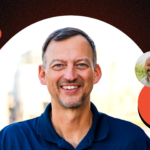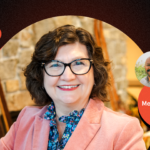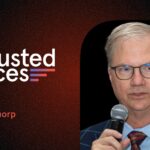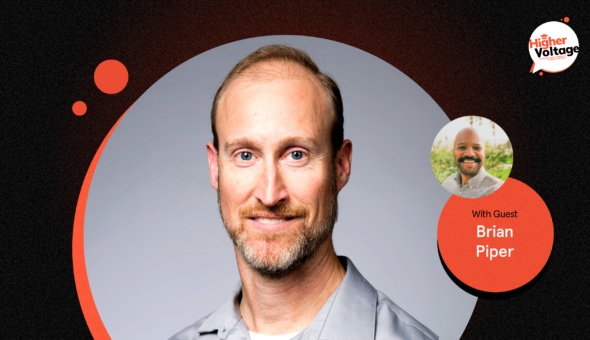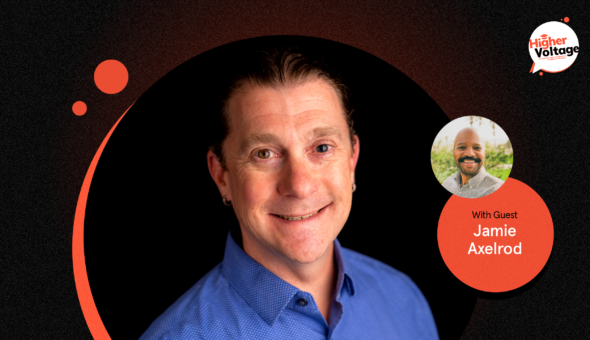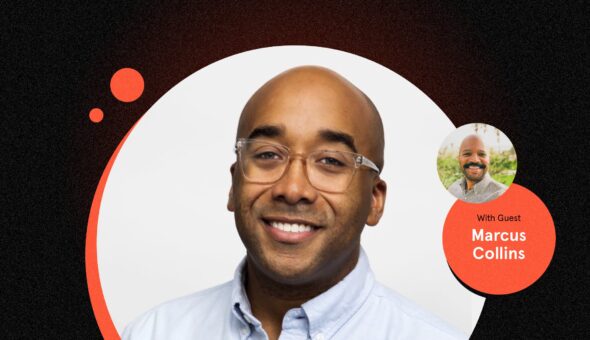In this episode of the Trusted Voices Podcast, hosts Erin Hennessy and Teresa Valerio Parrot discuss the intersection of higher education and the workforce with guest Paul Fain, a journalist focused on that nexus. Notably, the involvement of influential organizations like the Carnegie Foundation and ETS in promoting competency-based education and career planning may lead to lasting changes in traditional higher education and impact the conventional undergraduate student experience.
Paul Fain on the Bridge Between Education and the Workforce
The creator of The Job newsletter and the related weekly publication Work Shift joins Teresa and Erin to dig into the practical application of a degree and the importance of prioritizing work readiness.
“I think the vast majority of people who work in higher education care about their students’ success after college…. For those who are skeptical about whether you should care about work, I think you probably can do more than one thing at once.”
After their discussion with Paul, Teresa and Erin reflect on the need for collaboration between higher ed institutions, businesses and communities to address workforce development needs, noting that a one-size-fits-all approach and scalability may no longer be the end goal. The duo also consider the ramifications on the recent FAFSA deadline changes and the pending loan repayment programs, as well as the importance of communication with student journalists.
Show Notes
- Waiting for FAFSA
- Rollout of Biden’s New Student Loan Repayment Plan Hits Early Snags
- College Officials Should Work with Student Journalists, Not Avoid Them
Specific to the Discussion with Paul Fain
Read the full transcript here
Erin Hennessy:
Hello and welcome to the Trusted Voices Podcast. I’m Erin Hennessy, alongside Teresa Valerio Parrot. And in each episode, we discuss the latest news and biggest issues facing higher ed leaders through a communications lens. For these conversations, we’ll be joined by a guest who will share their own experiences and perspectives.
Teresa, it’s so good to see your face and also hear your voice. You know I’ve been on the road a bit recently, and you have been as well. And I feel like one of the first things that always falls away when we’re both traveling is our ability to just sort of find time to connect and catch up. So I’m excited to hear what’s on your mind this week. But as I told you, I’m going to go a little bit rogue and not necessarily bring up something that’s in the news in higher ed, but to share something that is on my mind from my recent campus visits. And it is this: there’s a lot of angst; there’s a lot of concern; there’s a lot of worry about enrollment and programs and revenue and political pressures.
And those are all very important topics, but one of the things that keeps coming up that is really worrying me is hearing from presidents and senior leaders that they have stopped talking to their student journalists. And you know that this is a particular soapbox of mine. We will add to the show notes a link to a piece that our friend Kristine Maloney and I wrote for Pointer about the obligation higher education leaders have to work with their student journalists.
And it is just so worrying to me to sit with folks who are smart and committed to student success and to student education and all of these things and hear them say, “I will not speak to student journalists unless I get questions in writing. And even then, I’m not really willing or excited to do this.” I don’t know if you’ve been hearing that on your campuses, but it really is just something that eats away at my heart as we travel the country and meet with leaders.
Teresa Valerio Parrot:
I’m actually excited to say this fall, I’m not facing that, and I think it’s because with a number of our campuses, I’ve been working so hard for honestly years to gain confidence for the administrators to have conversations with, as you point out, your students, and to have communications in places that students may read. And there’s a vulnerability there. And as you and I talk about, so much of the work that we do is helping people to gain comfort in having an appropriate amount of vulnerability.
And this is one of those areas that we have to push on quite a bit. So for my presidents who are participating with their student journalists, thank you. And also, again, for some of them it’s taken years to have that level of comfort and to think through how best to partner with them because that’s really what you’re doing. They are journalists, they are covering you, and also, they are your students and members of your community. So I’m not in that space and I’m so appreciative not to be there.
And I say that today because you could ask me tomorrow and I may be right back there having boomeranged because an insecurity or a vulnerability or a real story just popped up on a campus.
Erin Hennessy:
We talk about this all the time, and I’ve probably mentioned it on the podcast before, but it is so concerning to see senior leaders and presidents shift their students from their students, our students, to those people, whether it is students who are protesting, whether it is student journalists. I understand the emotional reaction, and yet in this day and age, we really need to keep front and center that these are our students.
Teresa Valerio Parrot:
We both hold presidents to reflection on their intonation when they say they, those students, right? However, it might be framed to stop and just say, “Let’s just stop and think about who we’re talking about.” You may have a disagreement with them. You may not like their approach. You may know that they’re about to break something really big for your campus, but they’re still yours.
Erin Hennessy:
Yep. What’s on your mind this week?
Teresa Valerio Parrot:
It’s October and I’m a little itchy right now because normally I’m encouraging every student who is a senior in high school or is in college to apply for the FAFSA. So there was a piece in Inside Higher Ed that Katherine Knott and Liam Knox wrote called Waiting For FAFSA, and I’m right there with them. It looks like it’ll probably open in December.
But for so many of us, there are cycles to when we’re having students do a number of different things and to have families and students fill out applications right now and at the same time fill out FAFSA is a really important one-two punch, and to separate the two of those makes me nervous for what FAFSA completion numbers are going to look like.
And at the same time, for those who went to college and have student loans, I’m also following the conversations around the rollout that Biden had for his new student loan repayment. Danielle Douglas-Gabriel had a fantastic piece in the Washington Post talking about the early snags that they’re hitting, including that some people are getting multiple statements and those statements may have different numbers for what it is that people now have to be paying. Some people aren’t getting anything.
A number of people are just getting confused. Let me put it that way. So I think we have both sides of this. Those who we need to have applied for financial aid, so they either are taking out fewer loans or no loans, and those who’ve taken out loans who are really not in an ideal position themselves to know what to do next.
Erin Hennessy:
And then the dark cloud that’s hanging over all of this, which we averted a couple weeks ago, but will come up again in November, the intersection of a potential federal government shutdown with all of these activities, both opening of the FAFSA, as well as smoothing out some of these glitches in the student loan repayment process that could complicate things enormously for students, families, borrowers, institutions even as we look at the impacts of all of this. So it’s a real hold your breath and cross your fingers kind of time of year right now.
Teresa Valerio Parrot:
Yeah. I do have a bridge to our guest for this episode though, and that is I’ve been missing being in a classroom and I’ve been missing thinking about all of the different topics that you get when you’re in a class. So I just recently went to my local library and got another library card. I have one for my local library, and then my countywide library. And I just signed up for, this will be near and dear to your heart, a sign language class that is online, that is a partnership between a community college and my public library.
And they are trying to recruit more people to learn sign language because they’re realizing that they need to have more people, whether it is in the workplace or it is just out and about, and especially as we think about first responders and people in the community who can be of assistance in an emergency to know sign language. So make sure, everybody, you get your library card and you know exactly what all it entails and maybe how you might be able to help others, whether it’s in your work or in theirs.
Erin Hennessy:
Wow, that’s a very uplifting Pollyanna.
Teresa Valerio Parrot:
Absolutely.
Erin Hennessy:
Yes. But as you point out, that’s a perfect bridge to our guest, Paul Fain, who is the creator of a great newsletter called The Job, as well as a weekly publication called Work Shift. And I’m excited to jump right into that conversation.
Ad Read:
Higher ed is changing fast. From declining enrollments, falling trust in public institutions, and the rise of artificial intelligence, higher education leaders have never faced greater challenges than they do now. Higher Voltage is a regular podcast hosted by industry veteran Kevin Tyler.
In each episode, he talks to higher ed leaders and experts to get their take on what’s working, what’s not, and what has to change. Higher Voltage isn’t just for anyone who works in higher education, it’s for anyone who is interested in or cares about higher education. Listen to Higher Voltage anywhere you get your podcasts.
Erin Hennessy:
Paul Fain is a journalist focused on the nexus between education and work. He writes The Job, a newsletter that explores those issues and helped create a related weekly publication, Work Shift. From 2011 to 2020, Fain was a reporter and editor at Inside Higher Ed. He oversaw the news outlet’s coverage of low-income students, college completion, community colleges, federal policy, emerging models of higher education, and the COVID-19 pandemic.
In addition to all that, Paul is a dear friend and longtime colleague of both of us, and we are absolutely delighted to have him with us today. Teresa, I will give you the honor of the first question today.
Teresa Valerio Parrot:
Excellent. Thank you and welcome, Paul. You and I have worked together for years, including on some of the topics that you now report on. And as we’ve experienced, in some higher ed circles, it’s really considered pretty distasteful to talk about work and especially work as an influence on our industry.
And yet we hear some employers, students and their families are interested in that practical application of a degree, or maybe they’re interested in a certificate or other credential that has immediate application for their job. I’d be curious to hear how you think about the differences in perspectives and expectations based on what you’ve heard as a reporter and what you report on related topics and if you have suggestions for bridging that gap.
Paul Fain:
Good question. Before I answer it, thanks for having me. You all are doing great work with the pod. So, honored to be here. Yeah, so I got to say, I believe that there is distaste out there. I don’t hear it and I personally think it’s probably overstated. I think the vast majority of people who work in higher education care about their students’ success after college. It may be a thing in the punditry world, but I don’t think it is in most circles. For those who are skeptical about whether you should care about work, I think you probably can do more than one thing at once.
You could do all the other things that colleges do and also care about work. You have career services offices that are designed to do that. You should probably invest more in them. But why is it important? Just briefly, we all know the data, like 80% of students say it’s the top priority. You can contest that data, but it’s obviously a top priority. And why is that? Well, we don’t have a great social safety net in this country. So unless you’re independently wealthy, you will need to work.
And those who don’t care about work might be independently wealthy, that would work for those people, but I don’t really report on them. I think obviously careers… Everybody wants a happy, well-paying career, and it’s important to your health among many other things. So obviously this is something we should care about.
Erin Hennessy:
As Teresa pointed out, I guess I’m going to ask you to dig just a little bit deeper here, Paul, but the gap between these worlds can seem pretty big, but we’re starting to see some major players that really haven’t played in this space before to my knowledge, and correct me if I’m wrong. Players like the Carnegie Foundation, like ETS and others start to move their programming toward things like competency, career planning, CTE, career and technical education.
Can you tell us a little bit more about what you’re seeing in the field and tell us what you think is driving that shift and what long-term impacts might look like for more “traditional higher ed,” more of the four-year undergrad traditional age student world?
Paul Fain:
Absolutely. So obviously these issues were big and important before the pandemic. The pandemic really tore away the curtain to show how hard it is for particularly underserved students to break into a good career. But the speed of the labor market, this is a crazy labor market. When I started the newsletter, I had a feeling that things were going to be weird in American society for a while, but I didn’t think it would accelerate the change in the labor market to the degree that it has.
So it’s always a stressful time to graduate from college. It’s got to be so much more so now, even for really privileged students who go to elite institutions. I mean, part of it is that jobs are changing so fast. I’m skeptical of some of these numbers too, but I saw one recently that by 2030, 85% of jobs will essentially be different. And having gone through an industry’s collapse myself, being prepared for the nimbleness required to reinvent yourself is really important. And I think that’s what organizations like ETS are responding to.
This is a market-demand thing. Families care about this. I’m going to be writing this week about what the college board is doing around career planning. It’s mind-blowing the degree to which they are focusing on this. It’s hard to even characterize briefly. It’s not just them. I think you’re going to see… The irony, unfortunately, is the people who need the most help are going to get the least help as higher education and the many industries that support students in post-secondary education focus more on career connections.
The kids who go to Duke and Stanford are going to get the best, and there’s a lot there. The real challenge is can we make sure that lower budgeted institutions and people get some of those assists?
Erin Hennessy:
Are there institutions or classes of institution or a type of institution that you would point us to? Obviously, the elite institutions approach this as more of a networking and connection kind of emphasis. But where do you see institutions doing good work here adapting to students’ desires for short-term credentials for some of those other things that the elites might not be willing to move into?
Paul Fain:
Yeah, good question. Another thing that the pandemic showed us, speaking obviously, but sometimes obvious points get lost in these debates, but social capital matters a lot. Raj Chetty and his colleagues at Opportunity Insights at Harvard have showed us maybe more than the quality of the education itself. I think everybody knows that it’s not what you know, it’s who you know. That’s a thing. That’s real.
And it’s also expensive to develop the social capital assists that you need and don’t have if you’re not like me, someone whose parents went to college and understand how to play that game. So yeah, resources are big here, and I think there’s a lot of interesting work happening. To pick an obvious one, CUNY’s ASAP program is one that tries to do all the support services, the wraparound supports, whatever you want to call them, to help students not only with social capital, maybe even less about social capital in this case, but the supports they need just to complete.
But I think at a lower budget threshold than a lot of elite institutions can do, you are seeing interesting experiential learning offerings coming from community colleges even. Thinking about Break Through Tech, if you haven’t heard of it, it’s a super interesting group, a nonprofit that provides micro internships, they call them ‘sprinternships,’ for particularly women and people of color just to get a short-term internship, to try to get a full-time internship, to try to get a job in tech, because they realized that even getting an internship is very hard if you don’t go to a highly selective institution.
I could give you some depressing numbers about how hard it is to break into a job in tech if you don’t go to a highly selective institution. On the whole, I think there’s a lot of interest in bringing in partners from outside higher ed to help make those connections, and I can give you a few examples if you’d like, but I’ll stop there.
Teresa Valerio Parrot:
Well, I’ll go ahead and pick up on that thread, because you’re reporting on education in the workforce often includes stories of collaboration and partnership as you’re talking about. Can you give us an example as you were just talking about where you see a business or a community working really well with the higher education sector to address training and workforce development needs?
And what are the components of their collaboration that you think can be applied elsewhere, whether that is a community college or it’s a regional comprehensive, or you’re going up to an elite private?
Paul Fain:
Absolutely. It’s paradoxical in that I think a lot of people in higher education rightly feel like they’re under attack right now. And I do have empathy for that, but I also think the Raj Chetty research shows higher ed can’t fix this alone. Economic mobility, social mobility, I’m afraid we have a pretty clear answer that it’s going to require a lot more than what higher ed can do to help people move into jobs. And I just have to say this, I always like to say this, when we talk about mobility, that means somebody’s coming up. How does somebody come up if people don’t give something up? Just something to think about and I think something we don’t do very well on either side of the political spectrum.
But yeah, you need everybody. It’s all hands on deck to pull someone out of low wages or underserved background to a good career. So that means local nonprofits, that means government, that means higher education, that means employers, that often means philanthropies. I’ll give you an example of this.
It’s an interesting one. edX, which is the boot camp provider that’s owned by 2U, has started a local community strategy. They started in Tulsa, and they just moved into Huntsville, Alabama. They offer short-term tech training for free funded by a philanthropy Truist, in Huntsville’s case, using nonprofits like the United Way to do a lot of things like transportation and childcare that people need. And government is there too. Oh, yes, and there’s a credit pathway. Drake State in Huntsville offers people that on-ramp to a degree via credit.
So that’s an unusually broad example, but there’s a lot more like that. And in a lot of cases, the community colleges take the lead. Pima Community College and Arizona is a real front-runner in employer partnerships. They have 700 of them, each one of them very complex. Wake Tech and Durham Tech in North Carolina also very good at bringing employers in. And just briefly, I’m talking about paying for things, doing things more than sitting on an advisory board, really getting involved, and — this is controversial with curriculum development — making sure that the skills apply to jobs so that they’ll actually hire graduates of these programs, and in some cases, providing instructors and equipment. It turns out, unfortunately, that high-demand fields are expensive. The instructors get hired away from higher ed to work in industry because they’re high demand. And if they’re often technical, they require equipment. So I’ll stop there, but there’s a lot going on and it’s kind of a thousand points of light. It’s small local partnerships that really touch all the bases that seem most promising.
Teresa Valerio Parrot:
Well, and to that point, I think even if it’s a thousand points of light, that light’s hitting someone and that’s helping someone in their mobility pursuit. So, bravo. I do have a question on that. You were talking about how this is more than higher education can do on its own, yet the narrative that we continue to hear is higher education isn’t doing enough, right? So there’s this paradox that we find.
What do you think would help to break through that, especially because you are seeing these examples? There are communities experiencing the benefits, but we still see that the general public expects that this is a pursuit just for higher education.
Paul Fain:
Yeah. I mean, that gets into some really tough stuff and I obviously don’t have all the answers there. I mean, I think looking back at the early college completion push, it’s hard for me to even remember that when I was at The Chronicle or Inside Higher Ed, sometimes in the very beginning of that, even community college presidents would come in and say, “Hey, we’re not really sure why people attend colleges. Is it really our responsibility to make sure they get to the completion?”
Well, nobody’s going to say that now and keep their job. So I think higher ed, it’s got a long way to go on this. Two things can be true. Again, yes, higher ed is not entirely responsible for the failures of the economic mobility of its students, but it’s also part of the problem, let’s be honest. There’s a lot of work that higher education needs to do to open more doors for low-income students. But I think to look back at the completion agenda’s early struggles, there was a lot of passing the buck then.
It was like, well, K12 academic preparation, blah, blah, blah. Now you’ve got, well, the employers don’t hire people. What are we supposed to do? We don’t control the labor market. True. And actually, I think one of the things… It’s putting more pressure on employers in a good way, like hey, if you all thought higher ed is stuck in its ways of doing things and is not open to new ways of opening opportunities, guess what? Corporate America is just as bad. I hear this all the time. CEO is like, “Hey, we need to have apprenticeships. We need to hire people without four-year degrees.”
HR is like, “Uh, okay, sure, whatever. I’m going to keep doing my job the way I do it, and this four-year degree is a great proxy for a hire that I know is more likely to succeed.” That’s not necessarily true, but getting that change is going to be really hard. And I think this is where governments can play a role, and I have to be positive here. I feel like a Pollyanna, but I actually feel this.
Teresa Valerio Parrot:
Lean into your Pollyanna. I will be happy to join you there.
Paul Fain:
It’s been happening a lot lately, and I don’t know what to do with that, but the federal government has a lot of problems. I do think the Congress and the White House sound a lot like each other when it comes to support for apprenticeships, super bipartisan, short-term credentials, you’ve got a lot of bipartisanship there. So there is some movement there, but the states, they can’t wait on Washington’s dysfunction. And you’re starting to see a lot more, I think, awareness that this is going to cost money.
This is going to require incentives to bring K12 and employers together with higher ed. And there’s a lot of action. And this is not a red or a blue state-only thing. I mean, you think about Colorado is a real front-runner, Virginia. Alabama may be the Promised Land for workforce development and education coming together, and they’re also studying each other, which is exciting.
And the reason that gives me this hope is that the problems are so severe you really can’t ignore them anymore if you’re in leadership of a state. The employers cannot hire enough people. You’ve got real labor market participation problems that are all hands on deck.
Erin Hennessy:
Fain, you’re just so smart and it’s deeply aggravating at times. But listening to you talk with such intelligence and passion about this is just such a privilege. And obviously, these are big issues and, as you said, I don’t think there’s anybody who has all the answers, but I’m thrilled that you’re out there chasing a lot of them. I want to hit a little bit of a hard pivot and take advantage of having you here to talk a little bit about the media landscape and particularly the higher ed trade media landscape.
You’ve hit a bunch of the big outlets, both The Chronicle of Higher Ed and Inside Higher Ed, as well as other publications outside of the higher ed trade space. Wanted to ask you if you could look back over your career covering higher ed and pick out one or two really big changes that you’ve seen in terms of what trade publications are covering, how they’re covering those topics, and where you might think the trade media is going next.
Are they following you into this workforce and education nexus, which I feel like you’re really out in front in terms of planting a flag, or are they going somewhere else?
Paul Fain:
Excellent question. And how many hours do you have again for this interview?
Erin Hennessy:
Several. Several.
Paul Fain:
Yeah. I think first and foremost, the big change driver as a journalist would be the enrollment crisis and its many ramifications, right? It’s been building for a long time. It accelerated during the pandemic. If you’re not paying attention to that, you either work at a highly selective institution or you have your head in the sand, right? And it changes so much. It drives the conversation on campuses about changing how you do business and how you view students and teaching, and that is really, really hard.
I think both The Chronicle and Inside Higher Ed are on that story big time. And even when I was at Inside Higher Ed during the early pandemic when we were starting to hear the rumblings of what was coming, COVID changed a lot. In terms of these issues, I definitely think the higher ed trade press is on it. I’m talking about the future of work and connections to careers and jobs, it’s really hard to do within a higher-ed trade publication. Like when I was at Inside Higher Ed, we sometimes would talk about some of the things I cover now, is this a higher ed story?
If I’m writing about a big corporate training program for frontline workers, sometimes we would say, wait a second, there’s actually no college in this, so I’m not sure if it fits under the brand. And they’ve done a really good job, I think, of trying to push… Inside Higher Ed in particular, I’m biased, they’ve tried, but there are times in entire issues I write that I talk to K12 or I talk to big companies and I don’t talk to any colleges, and that’s okay. But it’s very hard for a trade outlet that is focused on a specific audience, and let’s be blunt, on the revenue that is attached to that specific audience.
We knew it would be hard to do something like what I’m doing for a lot of reasons, and I have realized that that was actually true.
Teresa Valerio Parrot:
I do have a follow-up question to that because you’re talking about this enrollment cliff. And as you report, as you and I have worked on projects together, there are these adult students who are out there. And we still then revert in reporting and in talking about higher education to that traditional student population. And as an adult who went back to complete an additional degree, it was hard to navigate and to figure out how to work in how an institution operates now. And I was doing that as a doctoral student.
I can’t imagine what it would be like to go back as a continuing undergrad as an adult because it’s entirely different. Y’all those little pencils you had in the library to write down the Dewey Decimal number for the book you were going to look up, those don’t exist anymore, right? It’s so different. And my point really is, yet we still go back to talking about the traditional students and lamenting that we have this cliff and then talking about traditional students. There’s this disconnect with our reality and what it’s going to take to get there.
Paul Fain:
Absolutely. You can’t really generalize about anything in higher education. It’s so enorm… I’m telling you two this. You know this well. Not only every sector of higher ed, but you have to factor in the geography and the students served. Small institutions serve multiple different segments of students. So, very difficult. But I feel like all of this stuff, we kind of knew this all along, but this is all about our absolutely unsustainable wealth and income gap in this country that is out of control.
And higher ed is a big part of this problem, which I would put up there as our top two or three in the world right now. It’s not just the United States. We just happen to be worse about it than most developed countries when it comes to the wealth gap. But for people who attended a residential four-year college like me, that’s your default. That was a very formative experience. It’s understandable that you would focus on that, but it is just fascinating, even though that’s, what, one in five students in American higher education.
You all know the numbers, right? Like 45% of undergrads at community colleges. It is very hard to understand people’s lives that aren’t like yours, and we do a terrible job of that with higher education. And unfortunately, it’s turned into such a national issue, politicized national issue. Everybody feels like they have to have a hot take on it. Don’t need to tell the two of you. There are no easy answers to any of this stuff, and anyone who tells you there is wrong or ignorant. And the binary of college or no college, well, what are we talking about here? For who?
And I think to your point though, the vast majority of people start with the 18-year-old who just graduated high school. And the challenges for adult students, working learners is a term I like to use there, it was always hard. It’s harder now. We saw that in the pandemic, but people have less time than ever for this. I’m sure you both talked about the Brian Rosenberg, former Macalester President’s piece in The Chronicle.
I thought he nailed it on many levels, but the image that stuck with me was the empty buildings in the summer on his campus with the air conditioning running and one person in it and the 30 weeks of operation. That might work for Macalester. They can do that. But I’m sorry, if you’re running on that schedule, you’re not serving working learners.
Erin Hennessy:
Yep, and I think so many institutions had a brief period of looking at working learners as the silver bullet to solve the “demographic cliff” and very quickly realized they just aren’t built to serve them in any way, shape or form from…
Teresa Valerio Parrot:
They choose not to be built to serve them.
Erin Hennessy:
Exactly, from how we register to classes to when classes are held, to how the library…
Teresa Valerio Parrot:
How payment plans work. You need wifi. There’s so many different elements that they’re choosing not to serve them.
Erin Hennessy:
Yeah. Oh, absolutely.
Paul Fain:
And now I’m going to turn it into a status quo defender here. But if they did choose to, it’s super hard. It’s expensive, and that’s where I think…
Teresa Valerio Parrot:
To attract them and to retain them. It’s both of those, right?
Paul Fain:
Absolutely, yes. And to ensure that what you’re offering them will be valued in the workplace. And again, graduate programs, that’s one thing. A short-term certificate that is ideally, although probably not really stackable and that you can work on and you can chip away at a degree as you work. That’s the holy grail, right? That’s what we want. We want the on-ramps for people throughout their careers, but they are very hard to do and to sustain. I get this a lot from community college presidents.
That’s my peeps, right? Those are the people who I talk to the most about what’s happening out there. Unfortunately, governments don’t usually step up. They talk a lot about serving those students and then they don’t really help community colleges. That is changing. Texas just added a 30-plus percent bump to all community colleges with a targeted investment to serve these students. You want to see more of that. Do you really care, folks? It’s not cheap. And I think that goes for employers too. You can’t just say, “Oh, they’re not producing graduates,” and not be actively helping.
Teresa Valerio Parrot:
Yeah, agreed. Well, Paul, we are getting to the end of our time, but this is such an exciting moment for me because I get to use a line with you that I know you’ve asked me in interview settings. So here we go. Is there anything else you think we should have asked you to better understand the intersection of education and work?
Paul Fain:
I think you hit the bases. Each one of these questions felt like I could just keep going and going. But no, I mean, I think the only thing I will say is I think this moment, the one thing I didn’t say is you primed this with the ETS question. But I would take a good look at some of the very big entities that are moving more into this space because they can do some things that others didn’t. I picked edX for a reason. They have potential scale to replicate models. I definitely think local and specific is where you see the best real change on this hard work.
But I do think we’re going to start to see more and more big entities making plays here. And one of them I wrote about recently was IBM. They’re doing so much, it’s kind of hard to even get your arms around, with high schools, P-tech, with community colleges, particularly around cyber, and with hiring people without four-year degrees. They’re up to 20% of their new employees. So that’s an unusual company and how far they are down this path, but I think you’re going to see more like that.
Erin Hennessy:
Paul, you’re the very best and we so appreciate you making time to talk with us this morning. We are going to include a link to both The Job and Work Shift in the show notes for this episode, but do you want to give folks the website where they can sign up for the newsletter real quick?
Paul Fain:
Sure. It’s workshift.opencampusmedia.org. That’s a lot of words. And every time somebody asks me that, I realized maybe you should do something easier, but that’s for a different conversation.
Erin Hennessy:
The to-do list is long and you’ll get to it eventually.
Paul Fain:
I will.
Erin Hennessy:
We so appreciate you being here. Thanks for sharing your insights and your smarts about these really, really important topics that should be on everybody’s radar, not just those working directly at this intersection.
Paul Fain:
Thanks for having me, and thanks for all the work you’re doing in these interesting times.
Erin Hennessy:
Thank you, Paul.
I think this is going to be one of these show closings where you and I both fight over who adores our guest more.
Teresa Valerio Parrot:
I know. First of all, I always love his mind. I love his voice, and I think he looks like Dave Matthews. I’ve always told him this, and every time he just looks at me cross-eyed I think he looks and sounds like Dave Matthews, which based on my age and when I was in college, that’s about the highest compliment I can give someone.
Erin Hennessy:
Wow. Okay.
Teresa Valerio Parrot:
Let’s talk about what he talked about.
Erin Hennessy:
No, I don’t think there’s anything left to say. I think you just packed it all right in there. The thing that I love most about Paul is that he really does just completely immerse himself in the issues that he’s covering. He’s a smart and fair journalist. He’s willing to say the things that aren’t popular, the things that are contrary to the accepted or common wisdom. I’m thrilled that he has found a way to really branch out and dig into this work, which I think is really so necessary.
Teresa Valerio Parrot:
I agree. And I think he was very clear and careful and measured in how he set expectations for our industry and also for business. And yet, and that was the most Pollyanna I think I’ve ever heard Paul, was talking about partnerships and was talking about solutions and was talking about what’s on the horizon in a way that we all should be looking for that kind of positivity for the industry. So in an area where we often just hear critique, he was talking about adding positive pressure because it’s creating really significant solutions. And I appreciated that.
Erin Hennessy:
And I think we walk away from all of these conversations with six additional questions we wish we could ask, and one I would really love to dig into with Paul is, is scalability really a goal anymore? I mean, based on what he’s telling us, the action isn’t at the federal level, and that’s not surprising because often the federal government is too big and governs based on anecdote rather than good, solid data.
Sounds like the states maybe are the right funding partner, but it sounds like the partnerships that are being most successful, that are moving the needle, that are moving people into well-paying jobs really are local. And I think in higher ed, for so long the buzzword was scalability and how can we take a successful program and bring it to the masses? And maybe that’s the wrong goal to be pursuing, and I’d love to know what Paul would say about that because I’m just not sure we can do this at scale.
I mean, there are some players that I think are probably more successful at it. There’s the ASUs and the Southern New Hampshires and some of those institutions that have such large enrollments that they can work at those larger levels. But it really does feel to me like the most successful programs are those that really address a local need, a local culture, a local climate, and can be nimble because they are small.
Teresa Valerio Parrot:
Well, and I would reframe my question that I asked him. I asked about a business or a community working well with the higher education sector, and what he was telling us is it’s business and community working well with the higher education sector. And I think that’s key.
I had something that I just would love to hear more about, and that is this curriculum development that is being done. It sounds like maybe with, maybe without faculty. I would be very curious to hear how that’s going, how it’s being received, and what others might be able to learn from some of these examples that are out there.
Erin Hennessy:
Yeah, I think with some of our business school partners, we see industry informing curriculum, but you’re absolutely right. This isn’t informing so much as it is developing.
Teresa Valerio Parrot:
That just gave me the heeber-jeebers from a shared governance perspective.
Erin Hennessy:
Yeah. Yep, absolutely.
Teresa Valerio Parrot:
Unless, again, I don’t know enough. So it’s the question to ask, how are they making this work rather than are they making this work, because they are?
Erin Hennessy:
Right, right. And hopefully it’s not working just because the alternative was so dire that this felt like a good way out.
Teresa Valerio Parrot:
And then the other thought that I had is very early on when we were talking about the pushback that often work gets, it started to make me think, are we giving, not we, but is the media and all of the industry giving too much audience to the naysayers? So Paul said he doesn’t really hear it and he isn’t seeing it as much. And it made me wonder, am I living in a part of the industry where I’m giving greater audience to a smaller number? And we talk about this all the time.
What is the sample size of who you’re talking to? Maybe this is a moment for us to stop and reflect that even as we talk about these big issues in higher education. What is the sample size of the pushback, and are we missing out on opportunities because we’re giving it more credence than perhaps the numbers suggest?
Erin Hennessy:
Yeah, I think that’s a really excellent question, and the thing I would add to that is not just the sample size, but what does the sample look like? And if it is all elite or highly selective, traditional four-year residential, then maybe we need to be broadening who we’re having conversations with about that topic.
And I think, here comes the plug, the best way to do that is to make sure that we are subscribed to and opening and reading The Job and Work Shift each week, because I think Paul has a really unique ability to find great stories that push back on common tropes and bring those to the fore.
Teresa Valerio Parrot:
Agreed. Thank you for joining us for this episode. You can find links in the show notes to some of the topics and articles referenced, and remember that you can always contact us with feedback, questions, or guest suggestions at trustedvoices@tvpcommunications.com. Be sure to follow Trusted Voices wherever you get your podcasts, and we invite you to check out Higher Voltage, another podcast on the Volt Network that is hosted by our friend Kevin Tyler. Kevin explores the evolution of higher education that is happening right before our very eyes.
Until next time, thanks to Erin Hennessy, DJ Hauschild, Aaron Stern, Nicole Reed, and the Volt team for a great episode and thank you for listening.
Newsletter Sign up!
Stay current in digital strategy, brand amplification, design thinking and more.
Recent in Podcasts
Also in Podcasts
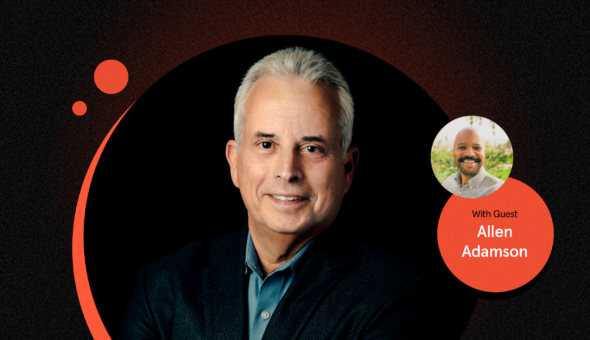
In a Word-Of-Mouth Business, No One Shares Average – Allen Adamson
Kevin and Allen discuss the importance of focusing on a clear and distinct mission, rather than diluting the institutional identity with multiple conflicting messages.
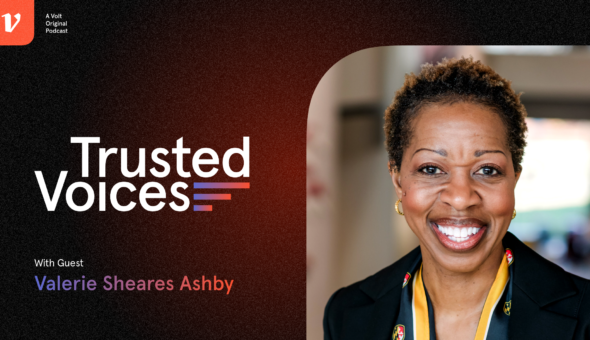
Valerie Sheares Ashby on Mentorship, Team Building and Measures of Success
President Valerie Sheares Ashby of the University of Maryland, Baltimore County discusses mentorship, team building and measures of success.
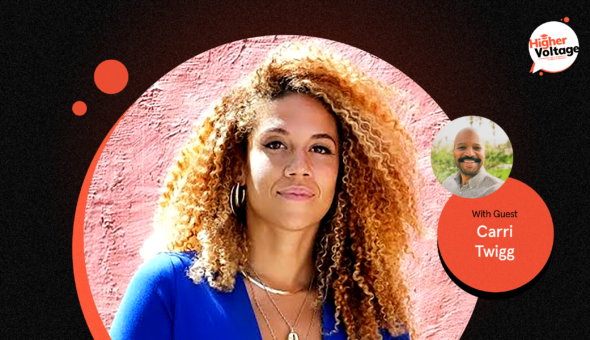
Finding Opportunity Amid Politicization
Kevin and Carri Twigg examine higher ed’s future in light of potential disruptions, a dismantled ED and shifts in institutional identity and collaboration.
